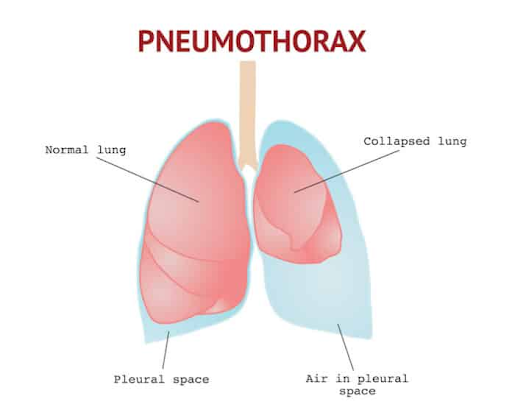Collapsed lung is also known as pneumothorax which is basically a health condition in which the lungs become unable to expand due to the air leakage of them into the chest of an individual. It is a severe medical issue that needs instant treatment under expert supervision so that it not only reduces the possible risk but also increases the chance of normal living again. Moreover, when it comes to the survival time of a person with a collapsed lung, it varies according to the affecting factors such as the extent of collapse, associated medical condition, and more. So, to give you complete information on this topic we compiled a complete guide answering How long can you live with a collapsed lung which covers top-to-toe information on this topic.
Symptoms of Collapsed Lungs
There are a lot of evident signs, behaviors, or symptoms that patients with collapsed lungs encounter in themselves and to know about some of the most common ones, read the below-shared points:

Live With A Collapsed Lung
- Extreme pain in the chest
- Lack of breath
- Regular cough and cold
- Fast breathing
- Feeling of dyspnea
- Anxiety and tiredness
- Extreme acidity
- Bluishness of lips and fingertips
- Fast heart beating rate
- Downfall in blood pressure
How long can you live with a collapsed lung?
Having a collapsed lung does not end an individual’s life or limit them on every activity that they used to perform before the detection of this condition. However, this medical issue demands quick consultation with a health provider and following their advised medications as well as exercising actively to stay fit and live longer.

Moreover, the period of time an individual can survive with a collapsed lung varies depending on the severity and other medical conditions happening in the body. No two pneumothorax patients go through the same thing as it has multiple causes and so do the different experiences.
Apart from this, to cope well with this medical condition the best option is surgery which is followed up with the right medications, respiratory therapies, breathing exercises, and so on. In such a situation, a patient’s recovery from the operation is directly related to the chance of better adjustment to the new life and the complications of pneumothorax.
Read more on How Long Is The Flu Contagious
Types of Lung Collapse
There are basically two types of pneumothorax which are traumatic pneumothorax and non-traumatic pneumothorax. Both of them have different effects, extinction, causes, and treatment. So, to know about them, read the description shared in this section.
1. Traumatic Pneumothorax
This type of lung collapse basically takes place due to certain major trauma or any external damage like minor or major injury to the lung wall. In this, the lung’s tissues break down and hence, result in leakage of the air from them into the pleural region. The causes of traumatic pneumothorax include situations like car collisions, any unintentional injury after healthcare treatment, hitting of the chest with something strong, and so on.
2. Non-traumatic pneumothorax
This is the type of lung collapse that is spontaneous and has no evident causes as it can happen due to multiple reasons. Unlike traumatic pneumothorax, it has nothing to deal with external damage or trauma. However, the potential causes of this can be any chronic infection, pneumonia, tuberculosis, asthma, cystic fibrosis, vascular diseases caused by collagen, COPS, lung cancer, consumption of narcotics, and so on.
Read more on How To Remove Mucus From Lungs Naturally
Collapsed Lung Treatment
There are multiple ways through which a severe collapsed lung can be treated and to know about them specifically, read the below shared remedies:

1. Draining of air
It is basically the removal of excessive air from the pleural regions of the lungs by surgeons through a surgical method. In this process, the physician injects a needle into the leakage cavity and slowly removes the air using needle aspiration. Moreover, the medical professionals fix a hollow tube in between the ribs of the patient so that the chest tube insertion can take place which allows the air into the lungs to fill and escape like normally.
2. Surgery
In this, the experienced and knowledgeable medical surgeons make an incision in the pleural regions of the lungs during the thoracotomy to detect the issues completely and study the lung’s severity. If they find multiple problems in that area or bouts of pneumothorax then they may treat the condition by fixing the voids or leakages from where the air was able to pass out. Not only this, but the healthcare provider can also perform pleurodesis which is a treatment process in which the lungs are being attached to the interior sides of the chest wall.
Learn more on Factors that Motivate People to Undergo Cosmetic Surgery
FAQs
1. What are the risk factors of pneumothorax?
Abnormal heartbeats, extreme pneumonia, failure of respiratory organs, blood clotting into the veins, slower blood circulation, shortening of breaths, excessive bleeding, and so on are some of the risk factors associated with pneumothorax.
2. Which tests are done to detect a collapsed lung?
X-rays, CT scans, medical history of the family, symptoms study, and ultrasonography are a few most common tests that a medical expert performs to check the conditions of the lungs at the current moment.
3. What are some post-collapsed lung surgery tips?
After days of hospitalization, close health conditions monitoring, a number of appointments with the doctors, and a successful surgery of a collapsed lung, an individual is advised to take enough bed rest, let the lungs re-expand fully, take proper medications on time, do the breathing exercises, quit smoking, eat healthy meals, avoid overthinking, say no to excessive hard work for a few days, and take frequent follow up of the recovery.
Conclusion
Above we shared a brief guide answering How long can you live with a collapsed lung along with its other aspects like types, causes, symptoms, recovery options, and so on which might have given you all the information related to this health condition. It is advised that the moment you feel any discomfort in your lungs, you should not ignore or delay and instead visit a medical expert for proper treatment. I hope the blog guided you well and if you still have anything further to ask then do connect with us through the comment box mentioned below.

